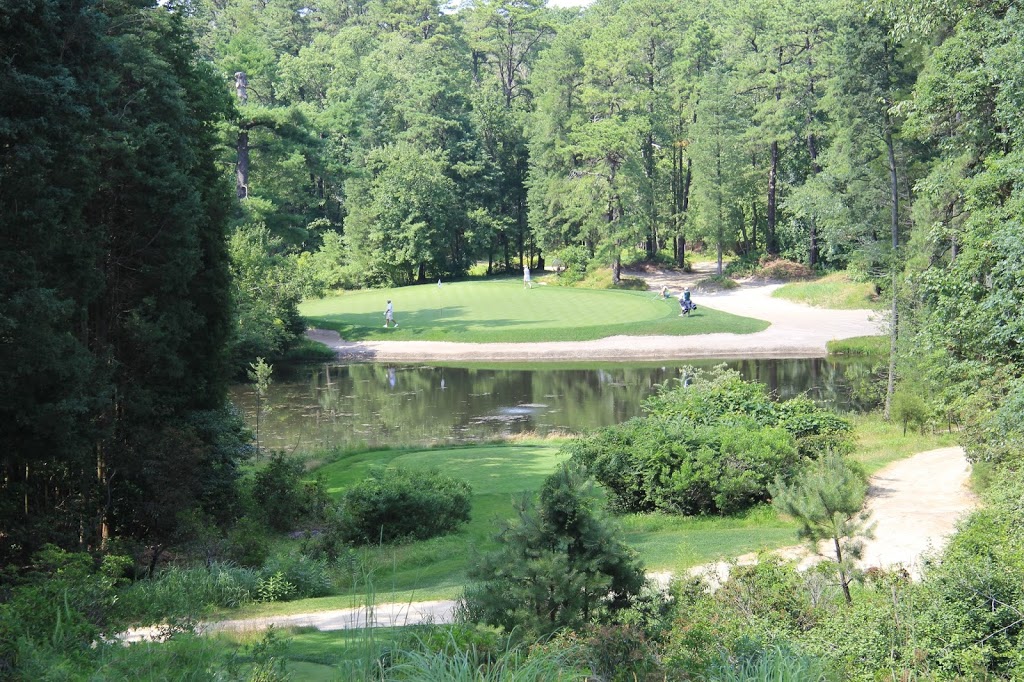**Photography is discouraged at the Crump Cup, therefore I've had to steal a few pictures for illustrative purposes. All of the fine photos that I've used in this Blog post are attributable to Graylyn Loomis from his review of Pine Valley on his website: http://www.graylynloomis.com/pine-valley-2/
Brigadoon is the name of a mythical village that appears from the fog of the Scottish moors for only one day every 100 years, only to disappear again at the stroke of midnight. For fans of golf course architecture, the ultra-private Pine Valley Golf Club may just be the closest thing to a real world Brigadoon. For only a few precious hours every year, on the afternoon of the final Sunday in September, Pine Valley seemingly magically appears from within a thick stand of the pine trees and pure sand in southern New Jersey, and its gates open to the public for the final round of an amateur tournament known as the Crump Cup. For these few magical hours, anyone who is interested may visit one of the undisputedly greatest golf courses in the world and wander around as he or she pleases, either taking in the competition or simply marveling at the superlative architecture and meditative ambiance. Once the final putt in the final match has been sunk, however, the public is ushered out, the gates close and the golf course once again becomes a golf playground for the world’s elite and their guests for another year.
Pine Valley was famously designed and built by an amateur one-off designer named George Arthur Crump, with the help and advice of many of the leading professional golf course architects of the day, including: Harry S. Colt (who designed the course’s final four holes after Crump’s death), A.W. Tillinghast, George C. Thomas Jr., Walter Travis, William Flynn and Hugh Wilson. Other architects who are reported to have visited (and possibly advised) during construction include C.B. Macdonald, Robert Hunter, Alister MacKenzie, Donald Ross, William Fownes, Charles Alison and Perry Maxwell. Talk about an all-star team of legendary design talent!
As a result, Pine Valley is widely considered one of the ultimate match play courses ever built – confounding golfers with a mixture of strategic, heroic and penal golf holes and always asking the golfer whether he or she wants to take on additional risk for additional reward. Above all else, though, variety is paramount. The overly penal holes (the do-or-die downhill par-3 14th and the long, uphill and very difficult par-3 5th) are balanced nicely by holes that require careful risk-reward consideration from the tee (the sweeping, dogleg right par-4 6th and the right-to-the-water's edge par-4 16th) and holes that require careful risk-reward consideration from the landing area into the green (par-5 7th (which includes the oft-copied Hell's Half Acre) and the wonderfully angled par-4 13th). Some holes simply ask the golfer to hit it as far as he can for an advantageous position (the long, par-4 12th), while others demand a more restrained approach for the best second shot (the short par-4 8th, with its severely sloped landing area and very small green(s)). The final long shot of the round - to an elevated 18th green protected by water and sand - has to be one of the great heroic shots in golf. Imagine how many matches have been won or lost by this approach shot in the last 90+ years!








The green complexes also offer no shortage of variety, from very large and falling from the front to the back (notably the 4th), to very small with a steep false front (the 8th and the 15th), wildly contoured (the 2nd and 3rd) and more subtle (the 16th). Some are guarded by bunkers and sandy waste in every direction (the 3rd and the 10th) while others are guarded primarily by only a single perfectly-placed bunker (the 16th) or no sand at all - only steep slopes (the 1st). Many invite run-up shots (the 4th and the 16th) while others can only be reached with an aerial shot (2nd, 7th, 17th).
Finally, the course has no shortage of iconic and intimidating features, including “Hell’s Half Acre” and the “Devil’s Asshole” bunker, plus sandy scrub waste areas as far as the eye can see!
It could be argued that the only repetitive element at Pine Valley (and, mind you, it's hard to nitpick the #1 course in the world), is the abundance of long and intimidating sand and/or water carries, to be found on most of the holes, which makes this a tough play for all but the most competent of golfers.




As for the 92nd Annual Crump Cup…
Having moved to Philadelphia earlier this summer, and now living only 30 miles from Pine Valley door-to-door, I eagerly took the opportunity to attend this year’s tournament and examine the legendary golf course more closely. The tournament is an invitational pitting mid-amateurs from around the U.S. and the format is stroke play qualifying for the first two days, followed by two days of match play, to determine the annual champion. This year, two amateur scratch-quality players, from San Francisco and Augusta, Georgia, won their first three matches and were meeting in the final.
It was interesting to watch the match as the course clearly influenced the strategy employed by each player. The player from San Francisco was a much longer hitter and the player from Augusta was noticeably more confident on and around the greens. I was told that they were both also members of Pine Valley so they clearly had a great deal of familiarity with the course and each other.
The match turned out to be very even, with neither player ever ahead by more than one hole. As the match progressed, the longer player from San Francisco took increasingly aggressive lines off the tee to try and gain an advantage over his shorter-hitting competitor. Meanwhile, the shorter-hitter from Augusta executed a number of flawless up-and-downs and long putts to not only remain competitive but actually lead most of the way. Ironically, the match was squared on the par-5 15th hole when the Augusta player matched the San Francisco player’s length but was unable to execute an up-and-down from a bunker behind the green. At the moment of greatest pressure, however, the big-hitter from California lost his drive left on the 18th and the match was over.
My takeaway from following this match was that the course neither rewarded nor punished one particular strength or style. The brilliant design and variety of the holes at Pine Valley seemingly brought out the best of each of their games, resulting in an exciting and competitive match between two very different players.
This was an experience that belongs on any golf fans' bucket list and I’m already looking forward to more intensive first-hand study next September!











